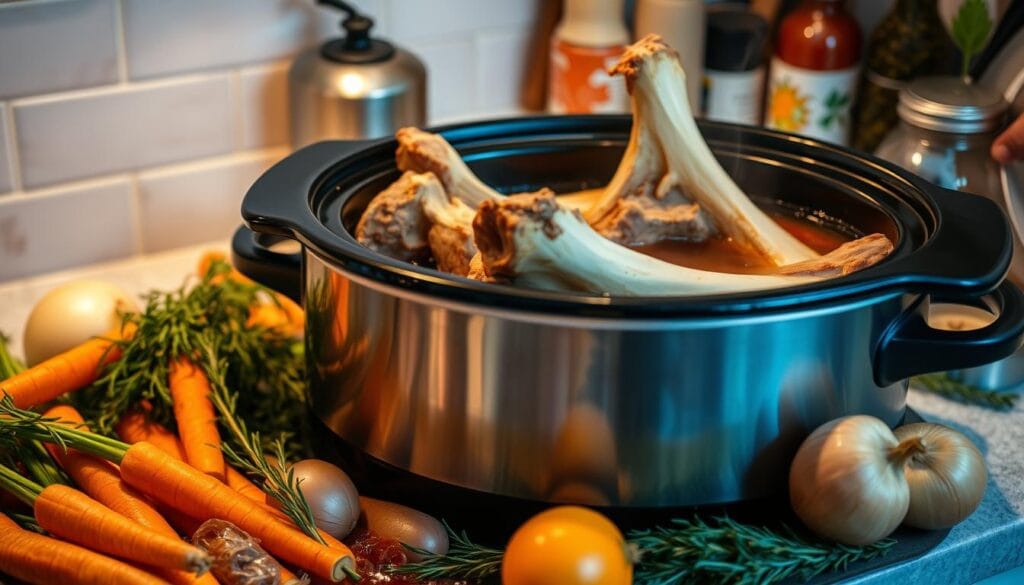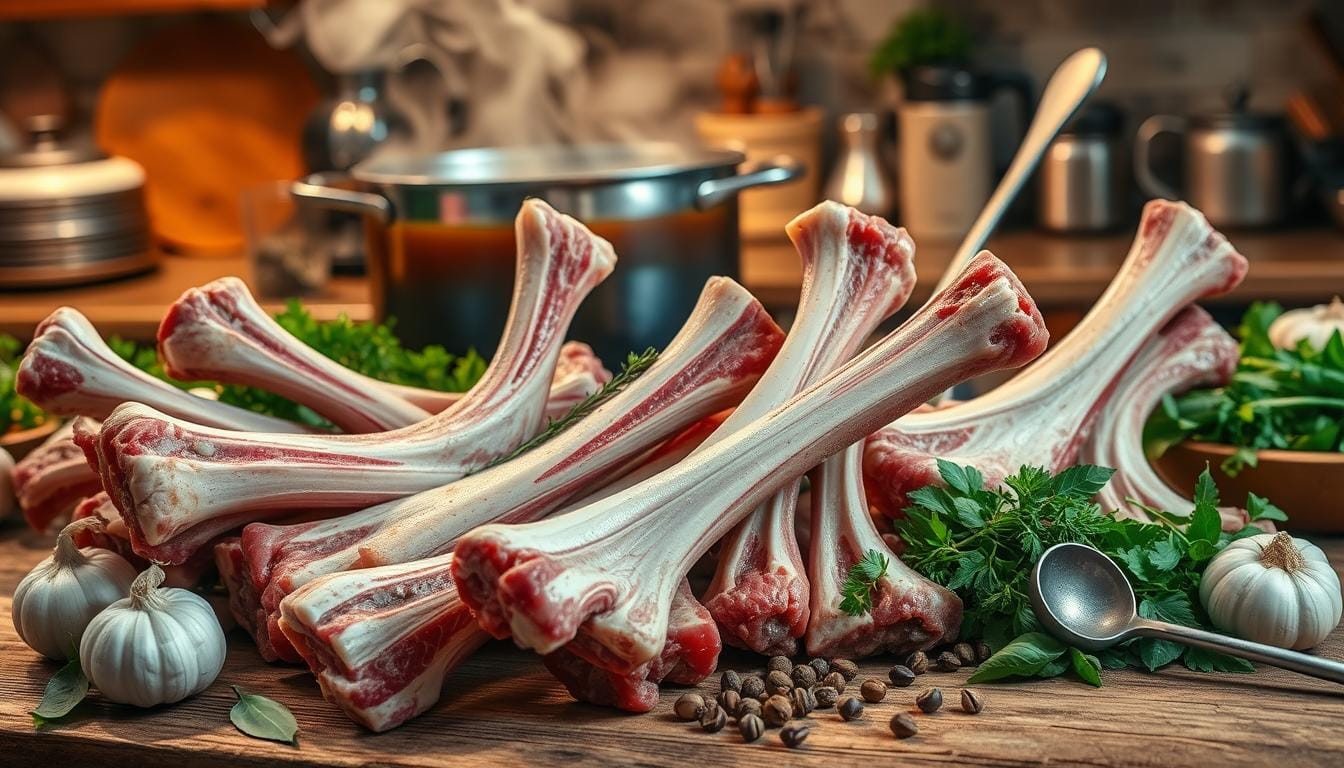How to cook beef neck meat for tender and flavorful results
Growing up, our family loved traditional cooking. We’d turn tough meat into delicious dishes. Beef neck bones were a weekend favorite, making a cheap cut into a feast.
Beef neck bones are a treasure in cooking. They come from the cow’s head and are full of flavor. Unlike pricey cuts, they add depth to any meal, making it unforgettable.
The key to tender beef neck meat is slow cooking. It breaks down the collagen, making the meat soft and rich. This method is perfect for tenderizing tough cuts.
Table of Contents
Understanding Beef Neck Bones as a Cut of Meat
Beef neck bones are a hidden gem in cooking. They turn simple ingredients into amazing dishes. They are a budget-friendly and tasty choice for making delicious beef neck meat recipes.
Beef neck bones are great for slow cooking. Their fat and connective tissues break down, making the meat tender and juicy.
Anatomy and Composition
The anatomy of beef neck bones includes many muscle groups and connective tissues. These features make them perfect for:
- Slow braising methods
- Developing deep, complex flavors
- Creating rich, gelatinous broths
Nutritional Benefits
Beef neck meat is good for your health. It has lots of protein and important nutrients:
| Nutrient | Amount per Serving |
|---|---|
| Protein | 25-30g |
| Calories | 360 kcal |
| Collagen | High concentration |
Why Choose Neck Bones for Cooking
Choosing neck bones for your recipes has many benefits. They are much cheaper than other beef cuts, costing about $5-$10 per pound compared to $20 for short ribs.
“Neck bones transform ordinary meals into extraordinary culinary experiences with minimal effort and maximum flavor.” – Professional Chef
Cooking them at 275-325 degrees Fahrenheit for 4-6 hours makes them tender and flavorful. This will impress any home cook looking to try beef neck meat recipes.
Essential Equipment and Tools for Cooking Beef Neck Meat
To make a tasty beef neck bones recipe, you need the right kitchen tools. The right equipment can make your cooking better and your meat more tender and flavorful.
Choosing the right cooking vessels and utensils is key. A few important tools can greatly improve your carnivore-style cooking.
Essential Cooking Tools
- Dutch Oven or Heavy-Bottomed Pot: Critical for even heat distribution and slow cooking
- Wooden Spoon: Perfect for deglazing and stirring without scratching cookware
- Slow Cooker or Oven: Ideal for achieving tender meat texture
- Sharp Meat Knife: Necessary for trimming and preparing neck bones
- Meat Thermometer: Ensures precise cooking temperatures
“The right tools transform ordinary cooking into a culinary art.” – Professional Chef
| Equipment | Purpose in Beef Neck Bones Recipe | Recommended Type |
|---|---|---|
| Dutch Oven | Slow cooking and braising | Cast iron with enamel coating |
| Slow Cooker | Hands-off cooking method | 6-8 quart capacity |
| Meat Thermometer | Temperature monitoring | Digital instant-read |
Investing in quality cooking tools will make your beef neck bones recipe better. Each tool is important for rich flavors and tender meat.
Selecting and Preparing Your Beef Neck Bones
Starting with beef neck bones in your recipes means choosing and preparing them right. Knowing how to pick and prepare these cuts is key to tasty dishes.
Quality Indicators for Beef Neck Bones
Look for these signs when picking beef neck bones:
- Fresh, bright red color with minimal discoloration
- Minimal excess fat and visible connective tissue
- Clean surface without strong unpleasant odors
- Consistent marbling throughout the meat
Cleaning and Trimming Process
Cleaning is vital for beef neck bones. Here’s how to do it:
- Rinse bones under cool running water
- Pat dry thoroughly with clean paper towels
- Trim excess fat using a sharp knife
- Remove any visible connective tissue
Initial Preparation Techniques
There are special ways to prepare beef neck bones for better flavor and tenderness:
| Preparation Step | Details |
|---|---|
| Temperature | Allow bones to reach room temperature (30-45 minutes) |
| Seasoning | Salt and pepper generously before cooking |
| Prep Time | 10 minutes total preparation |
Pro tip: Always handle raw meat with clean hands and sanitize surfaces to prevent cross-contamination.
Selecting high-quality beef neck bones is the first step to creating mouthwatering dishes that will impress your family and friends.
Beef Neck Bones Recipe Carnivore
Discover the deep, primal tastes of beef neck bones with this carnivore recipe. It’s all about pure meat, perfect for those who love intense flavors and nutrition. Neck bones beef is a top choice for meat lovers looking for a rich experience.
- 4 pounds beef neck bones
- 2 tablespoons sea salt
- 1 tablespoon black pepper
- 1 tablespoon garlic powder
- 1 tablespoon smoked paprika
Here’s how to make this carnivore neck bones beef dish:
- Preheat oven to 275°F
- Pat neck bones dry with paper towels
- Season with the given spices
- Sear bones in a hot skillet for 3-4 minutes each side
- Put them in a Dutch oven or deep roasting pan
| Cooking Parameter | Details |
|---|---|
| Cooking Temperature | 275°F |
| Cooking Duration | 4-6 hours |
| Serving Size | 4 people |
| Calories per Serving | 360 kcal |
Pro tip: Low and slow cooking makes the beef neck bones tender and flavorful.
“Neck bones represent the ultimate expression of pure, unadulterated meat enjoyment in the carnivore diet.” – Meat Enthusiast
For the best taste, let the neck bones rest for 15 minutes after cooking. This lets the juices spread evenly, making each bite juicy and delicious.
Traditional Braising Method for Perfect Results
Braising makes beef neck meat tender and flavorful. It’s a cooking technique that brings out the best in neck bones. This method creates dishes that are truly satisfying.
Searing Techniques for Maximum Flavor
The key to great beef neck meat recipes starts with searing. Here’s what chefs do:
- Pat the meat dry with paper towels
- Use a heavy-bottomed cast iron skillet
- Heat oil until it’s nearly smoking
- Sear meat for 3-4 minutes on each side
Liquid Ratios and Seasoning Secrets
Getting the braising right is all about precision. For beef neck meat recipes, keep these tips in mind:
- Use a 1:2 ratio of liquid to meat
- Choose bone broth for maximum flavor
- Season generously with kosher salt and black pepper
- Consider adding fresh herbs like thyme or rosemary
Mastering Cooking Times and Temperature
For beef neck meat recipes, slow cooking is best. Keep the temperature between 300°F to 350°F. Cook for 2-4 hours until the meat is fall-apart tender.
“Patience transforms tough meat into a culinary masterpiece” – Professional Chef’s Wisdom
Slow Cooker Method for Tender Neck Bones
Using a slow cooker makes recipes with beef neck bones super easy. This method turns tough meat into tender, delicious food with little effort.

Slow cooking brings out deep flavors and tenderness in beef neck bones. The low heat breaks down tough parts, making the meat fall-off-the-bone tender.
Slow Cooker Preparation Steps
- Select 2 to 4 pounds of beef neck bones
- Season generously with 2 teaspoons of salt and ½ teaspoon of black pepper
- Place neck bones in the slow cooker
- Add 4 cups of beef stock or water
- Cover and cook on low for 8 to 10 hours
Pro tip: For maximum flavor, sear the neck bones before placing them in the slow cooker.
Cooking Recommendations
| Cooking Setting | Time | Result |
|---|---|---|
| Low Heat | 8-10 hours | Most tender meat |
| High Heat | 5-6 hours | Quicker cooking |
Tip: Add vegetables during the last hour of cooking to prevent them from becoming mushy.
The slow cooker method makes beef neck bones incredibly tender. It’s perfect for home cooks who want tasty, easy meals.
Creating Rich and Flavorful Gravy from Cooking Liquid
Turning the cooking liquid from neck bones beef into a tasty gravy is an art. It makes your beef neck meat recipes even better. This process needs patience and skill to get deep, complex flavors.
Reduction Techniques for Intense Flavor
After taking out the cooked neck bones, focus on reducing the cooking liquid. You want a rich, velvety gravy with lots of flavor. Here’s how to do it:
- Strain the cooking liquid through a fine-mesh sieve
- Remove excess fat using a fat separator
- Simmer the liquid gently to reduce volume by approximately 50%
Seasoning Adjustments for Perfect Gravy
Seasoning is key to making a great gravy. Taste and adjust carefully to bring out the best in your beef neck meat.
“The secret to an outstanding gravy lies in layering flavors and tasting as you go.” – Professional Chef Recommendation
Here are some seasoning tips:
- Start with minimal salt to prevent over-seasoning
- Add fresh herbs like thyme or rosemary
- Use black pepper for depth
- A splash of red wine can intensify the flavor profile
The final gravy should be smooth and have a rich, intense taste. It should perfectly match your neck bones beef dish.
Best Wine and Stock Combinations
Choosing the right liquid for beef neck bones in a carnivore recipe is key. It’s all about picking the best bone broths and meat stocks. Fans of the carnivore diet know that the right liquid can make the dish taste amazing.
Here are some top stock choices for beef neck bones:
- Homemade beef bone broth
- Grass-fed beef stock
- Bone marrow broth
- Roasted beef stock
Pro tip: Choose bone broths high in collagen for tender beef neck bones.
“The quality of your stock determines the depth of flavor in your carnivore meal” – Carnivore Kitchen Wisdom
Mixing different bone broths can make your dish even better. Try combining roasted beef stock with bone marrow broth. This mix adds a rich, satisfying taste that goes well with the natural flavor of neck bones.
Here’s how to make your stock:
- Use bones from grass-fed cattle
- Roast bones before making stock for better flavor
- Simmer stock for at least 12-24 hours
- Strain well to get a clear stock
By picking and preparing your stock carefully, you’ll make your beef neck bones dish unforgettable.
Side Dishes and Accompaniments
Choosing the right side dishes can make your beef neck bones recipe special. They add to the rich flavor of the meat and make the meal balanced.

Traditional Carnivore-Friendly Pairings
For those who love meat, protein-rich sides are perfect. Here are some great options:
- Crispy bacon strips
- Seared organ meats like liver
- Soft-boiled eggs
- Additional beef cuts
Modern Serving Suggestions
Try new ways to serve your beef neck bones for a unique meal. Here are some ideas:
- Use beef tallow for extra richness
- Create a bone broth reduction
- Garnish with crispy meat chips
“The secret to an exceptional beef neck bones dish lies in thoughtful accompaniments that enhance the meat’s natural flavors.” – Professional Chef
Looking for something different? Try these options:
- Spicy pickled jalapeños
- Smoked sea salt garnish
- Rendered beef fat drizzle
The aim is to make a meal that’s full of protein and celebrates the beef’s flavor. It should also be balanced and nutritious.
Troubleshooting Common Cooking Issues
Cooking neck bones beef can sometimes present challenges for home chefs. Understanding how to address common cooking issues will help you create delicious beef neck meat recipes every time.
When preparing neck bones beef, tough meat is the most frequent problem. This typically occurs due to insufficient cooking time or improper preparation techniques. The key is patience and understanding the meat’s unique characteristics.
- Tough Meat Solution: Cook neck bones at low temperatures for extended periods. Slow cooking breaks down connective tissues, resulting in tender meat.
- Flavor Enhancement: If your beef neck meat recipes lack depth, experiment with different seasoning combinations and marinating techniques.
- Fat Management: Trim excess fat before cooking to prevent greasy texture and ensure optimal flavor.
Different cooking methods require specific approaches:
- Slow Cooker: Ensure adequate liquid and cook on low heat for 6-8 hours
- Braising: Use a tight-fitting lid to retain moisture
- Oven Roasting: Cover with foil to prevent excessive drying
“The secret to perfect neck bones is low and slow cooking” – Professional Chef Recommendation
Monitoring internal meat temperature is crucial. Aim for 195-205°F to guarantee tenderness in your beef neck meat recipes. Invest in a reliable meat thermometer to track progress accurately.
Storage and Reheating Guidelines
Keeping your beef neck bones recipe fresh is key. After cooking, you’ll want to keep the flavors and nutrients intact. This is especially important for a carnivore diet.
Refrigeration is the best way to store beef neck bones. Here are some important tips:
- Store in an airtight container
- Refrigerate within 2 hours of cooking
- Keep for up to 3-4 days maximum
When you reheat your beef neck bones, aim to keep them moist. Pro tip: Always add a splash of bone broth during reheating to maintain tenderness.
There are several ways to reheat your dish:
- Stovetop: Low heat, covered skillet
- Microwave: Short intervals with added broth
- Oven: Covered dish at low temperature
For the best carnivore diet experience, gentle reheating preserves the meat’s nutritional integrity and flavor profile.
Freezing is great for longer storage. Beef neck bones can be frozen for up to 3 months in freezer-safe containers.
Conclusion
Exploring recipes with beef neck bones opens up a world of flavor and nutrition for those on a carnivore diet. These cuts are often overlooked but offer a tasty and affordable protein source. They can turn simple meals into gourmet dishes.
The techniques shared in this article show how versatile beef neck meat can be. You can use traditional braising or try new slow cooker methods. The secret is to know how to prepare, season, and cook these cuts right.
Learning to cook neck bones can make you a master of budget-friendly protein. It’s perfect for those on a carnivore diet or anyone wanting to improve their cooking skills. Just remember to focus on preparation, cooking time, and temperature for the best results.
Don’t be afraid to try and make these cuts shine in your cooking. With a bit of patience and the right techniques, beef neck bones can be the highlight of your meal. They offer a delicious and satisfying experience that will wow even the pickiest eaters.


